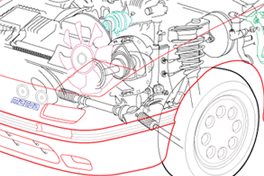 Learn About Print Quality
Learn About Print Quality
Lines
As a graphical element, lines are critical in representing data, providing visual separation of document sections, and contributing to artistic graphics; in fact, the prevalence of lines in printed material is overwhelming and nearly as common as text. Of these, the most common are vertical and horizontal ruled lines—fortunately the simplest to render on a rectilinear grid. Because of the geometry of such a grid, diagonal lines are subject to an increase in minimum thickness; a printer’s ability to maintain line thickness between the thinnest straight and diagonal lines is a tradeoff between offering thinner straight lines or greater uniformity.

While this uniformity issue is often of minor importance for discrete lines of different angles, curved lines require that they do not appear to vary in thickness unintentionally. In transitioning along curved lines from vertical or horizontal orientations to the angles between, many rendering algorithms will create noticeable artifacts that emphasize the jaggedness of the pixel grid.
In addition to width non-uniformity, lines often illustrate deficiencies such as drop out and ghosting, halftoning issues (some halftone algorithms are designed for use over large areas, but also employed in thin line situations), and color registration problems perpendicular to the orientation of the line.

